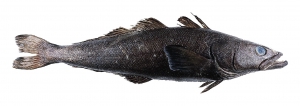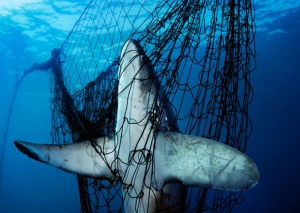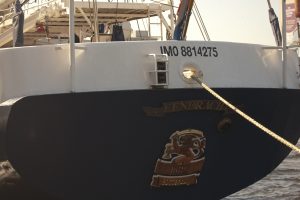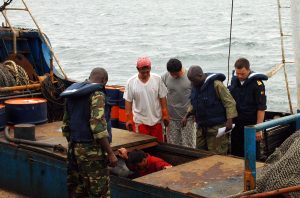It’s complicated: Understanding non-compliance in small-scale fisheries
By Peter Aronson, SRC Intern
Following regulations can be vital for conservation, yet the world’s realities place pressure onto people, which can incentivize non-compliance. This undermines conservation work and the positive ecological outcomes achieved by it. In the ocean specifically, short bursts of illegal fishing can negate the effects of decades of protection, especially for species whose populations take a long time to recover, like many sharks (Russ and Alcala, 2010). As shark populations have declined globally, conservationists have advocated for shark sanctuaries to be established to protect sharks from exploitation (Dulvy et al., 2014; Ward-Page and Worm, 2017). By understanding the motivations and traits of those not following regulations, strategies can be developed to increase compliance (Keane et al., 2008). Nearly all fishers in the world live in lower-income countries and are engaged in small-scale fisheries, but research on the behavioral drivers of illegal fishing has traditionally focused on recreational fishers in wealthier countries (Bova et al., 2017; World Bank et al., 2012). A group of scientists set out to Myanmar to study fishers’ awareness of, compliance with, and perceptions towards shark fishing regulations.
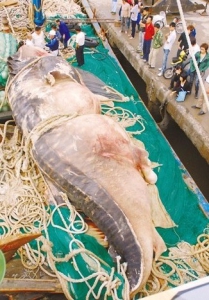
Figure 1) Populations of some shark species, such as whale sharks, have been in decline globally due to overexploitation. (Victor Researcher (2008). 21 Ton Whale Shark. WikiCommons.)
Myanmar prohibits the capture and sale of whale sharks and has two shark reserves in which shark fishing is not permitted; however, many fishers are unaware of these regulations. The Department of Fisheries also lacks the ability to enforce them. There is additionally ambiguity as the law was declared informally, and it doesn’t address instances of bycatch. Scientists studied five coastal communities they had well-established relationships with where prohibited shark fishing was known to occur. They conducted surveys with fishers, in which fishers could voluntarily answer whether, where, and when they had caught sharks and witnessed others catching sharks. Scientists found 40% of respondents had accidentally or intentionally caught an estimated 4821 sharks in the year prior to the survey (MacKeracher et al., 2020). Of the 58 respondents, 35 reported having caught sharks themselves (MacKeracher et al., 2020). Overall, 49% of respondents were aware of shark fishing rules, with levels of awareness varying among communities (MacKeracher et al., 2020). Shark fishers tended to be younger and not to own their own boat. Most sharks being caught fell within three families: bamboo and epaulette sharks (Hemiscylliidae), requiem sharks (Carcharhinidiae), and hammerhead sharks (Sphyrnidae) (MacKeracher et al., 2020). Nearly 80% of fishers came from the large coastal city of Myeik and sold their catch there and other large coastal cities, while the remainder of fishers from the local communities sold their catch locally (MacKeracher at al., 2020). Fishers who reported catching sharks themselves most commonly said they did so for money, and also mentioned food (MacKeracher et al., 2020).
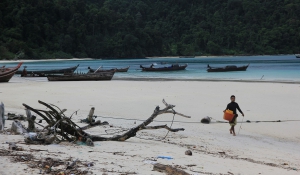
Figure 2) Boats in the Myeik Archipelago, Myanmar. (Go Myanmar. (2013). The Myeik Archipelago, Myanmar (Burma)[Photograph]. WikiCommons.)
Works Cited
Bova, C.S., S.J. Halse, S. Aswani, and W.M. Potts. 2017. Assessing a social norms approach for improving recreational fisheries compliance. Fisheries Management and Ecology 24: 117–125.
Dulvy, N.K., S.L. Fowler, J.A. Musick, R.D. Cavanagh, P.M. Kyne, L.R. Harrison, J.K. Carlson, L.N. Davidson, et al. 2014. Extinction risk and conservation of the world’s sharks and rays. eLife 3: e00590.
Keane, A., J.P. Jones, G. Edwards-Jones, and E.J. Milner-Gulland.2008. The sleeping policeman: Understanding issues of enforcement and compliance in conservation. Animal Conservation 11:75–82.
MacKeracher, T., Bergseth, B., Maung, K. M. C., Khine, Z. L., Phyu, E. T., Simpfendorfer, C. A., & Diedrich, A. (2020). Understanding non-compliance in small-scale fisheries: Shark fishing in Myanmar’s Myeik Archipelago. Ambio, 1-14.
Russ, G.R., and A.C. Alcala. 2010. Decadal-scale rebuilding of predator biomass in Philippine marine reserves. Oecologia 163: 1103–1106.
Ward-Paige, C.A., and B. Worm. 2017. Global evaluation of shark sanctuaries. Global Environmental Change 47: 174–189.
World Bank, Food Agriculture Organization, and WorldFish. 2012. Hidden harvests: The global contribution of capture fisheries, economic and sector work. Report No. 66469-GLB. Washington, DC: The World Bank.

